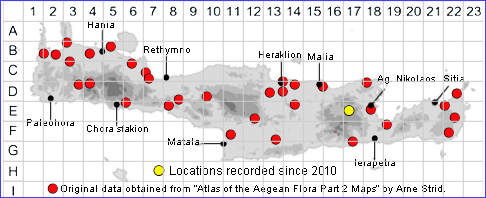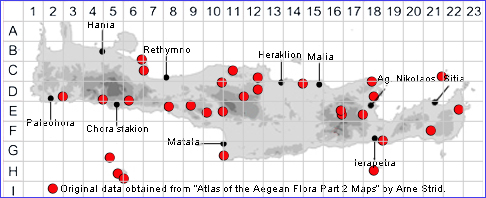
~~~~~~~~~~~~~~~~~~~~~~~~~~~~~~~~~~~~~~~~~~~~~~~~~~~~
SPECIES DESCRIPTION
CICHORIUM INTYBUS subsp. INTYBUS
Including Cichorium pumilum
Family and Genus:- See- COMPOSITAE
Common Name:- Chicory
Homotypic Synonyms:- None
Meaning:- Cichorium (Gr) A name used by the Greek philosopher Theophrastrus
from the Arabic 'kesher' for chicory.
Intybus (Gr) Wild chicory, from the Arabic 'tybi.'
General description:- Hairless, or somewhat stiffly-hairy, medium to tall perennial;
with a long, stout taproot.
Stems:-
1) 30-120 cm erect, with rigid, patent-ascending branches.
Leaves:-
1) Basal, 7-30 X 1-12 cm, oblanceolate, runcinate-pinnatifid to dentate, shortly
petiolate.
2) Cauline, with fewer teeth or entire, sessile, amplexicaul.
Flowers:-
1) Peduncles, of the terminal capitula slightly thickened at the apex.
2) Involucre, 11-14 X 4-10 mm.
a) outer bracts, c. 8, broadly lanceolate, patent at the apex.
b) Inner bracts, c. 5, twice as long as the outer and narrower, erect.
3) Ligules, bright blue, rarely pink or white, 3 times as long as the involucre.
Fruit:-
1) Achenes, 2-3 mm, irregularly angular, pale brown.
2) Pappus-scales, 1/10-1/8 as long as the achene.
Key features:-
1) Spine-like branches absent.
2) Involucre, 11-14 mm.
3) Peduncles, of terminal capitula slightly thickened at apex.
4) Pappus-scales, 1/10-1/8 as long as achene.
Habitat:- Roadsides, field margins, wasteland, occasionally in meadows and open
woodland. 0-1100 m.
Distribution:- Widespread and common across the Mediterranean. Widespread
and common on Crete.
Flowering time:- Mainly June-Sept.
Photos by:- Steve Lenton

CICHORIUM PUMILUM
Homotypic Synonyms:- Cichorium endivia var. pumilum, Cichorium endivia
subsp. pumilum, Cichorium intybus subsp. pumilum.
Meaning:- Pumilum (L) Dwarf.
Resembling Cichorium intybus subsp. intybus, but differering in the following
characters
1) Annual, with a slender taproot.
2) Basal leaves, few, not in a distinct rosette;
3) Leaves, often undivided, subentire to dentate;
4) Phyllaries, ciliate, the outer almost as long as the inner;
5) Pappus, scales 0.4-0.6 mm.
Habitat:- Cultivated and fallow fields, roadsides, occasionally in open dry shrubby
vegetation on eroded hill-sides, usually near the coast. 0-1100 m.
Distribution:- Scattered across the Mediterranean and through Anatolia to W & S
Iran. Scattered across Crete, not overly common.
Flowering time:- Mid-Apr to mid-July.
Photos by:- Fotis Samaritakis
